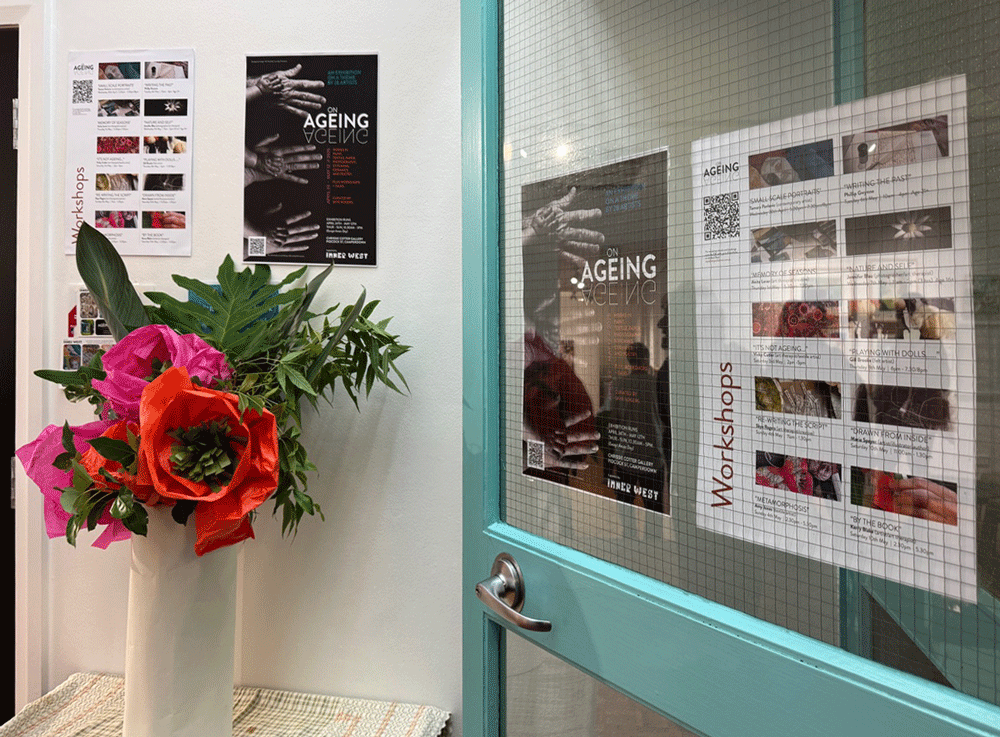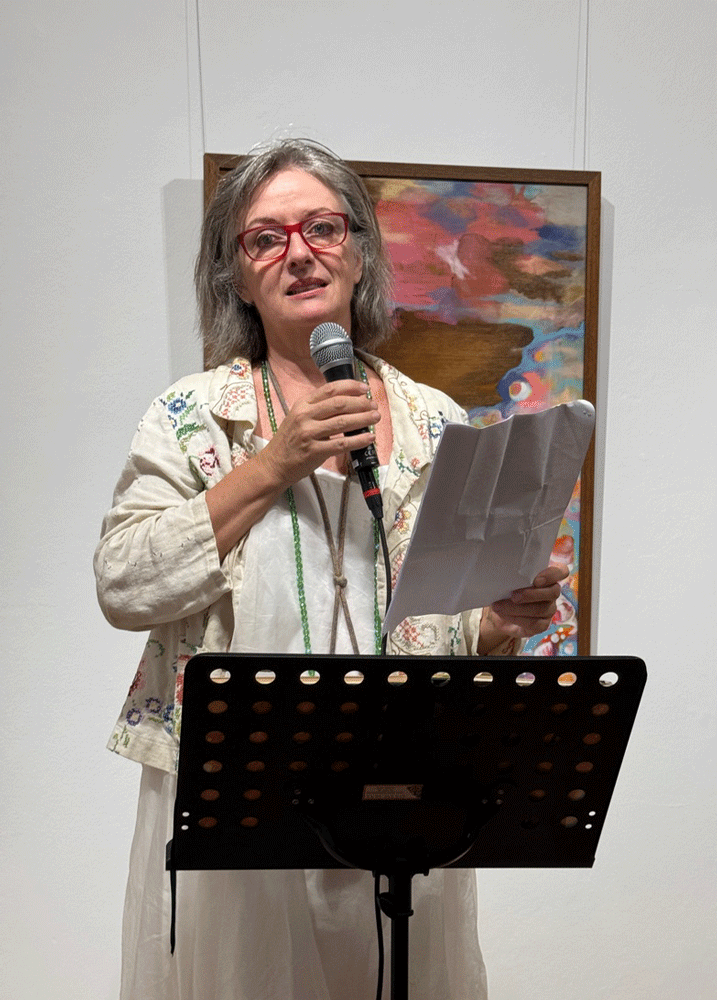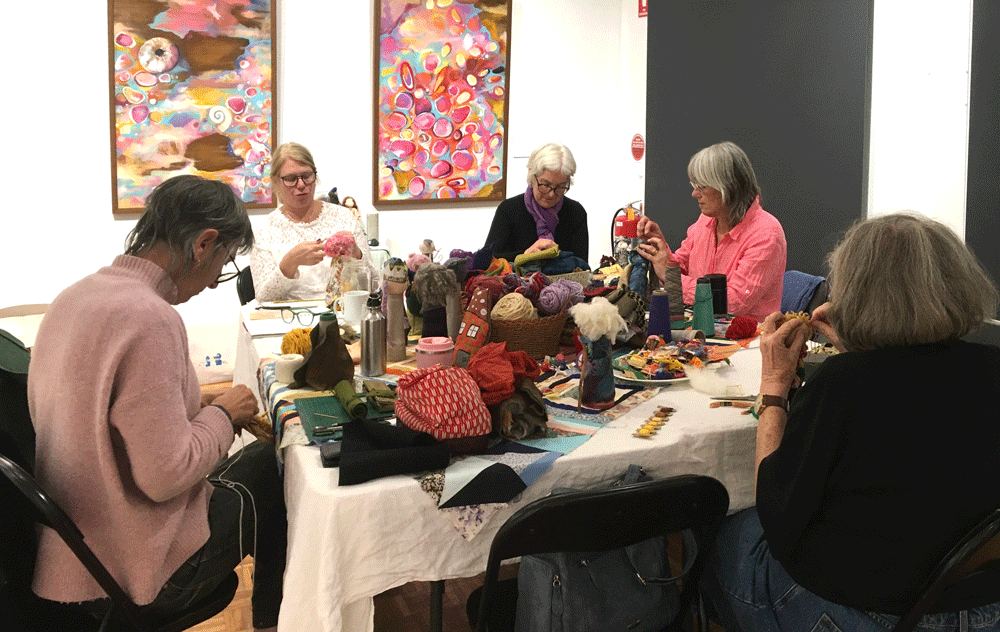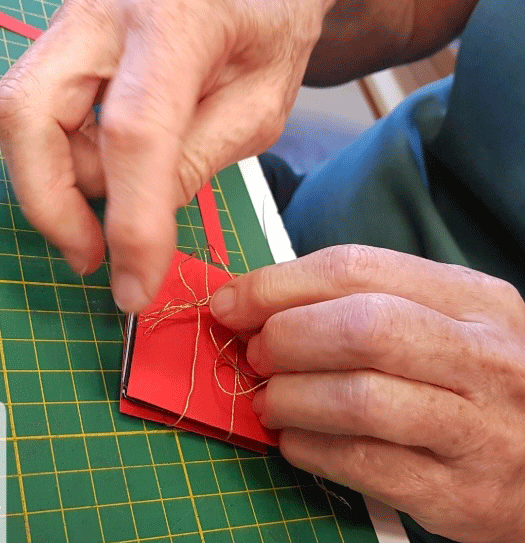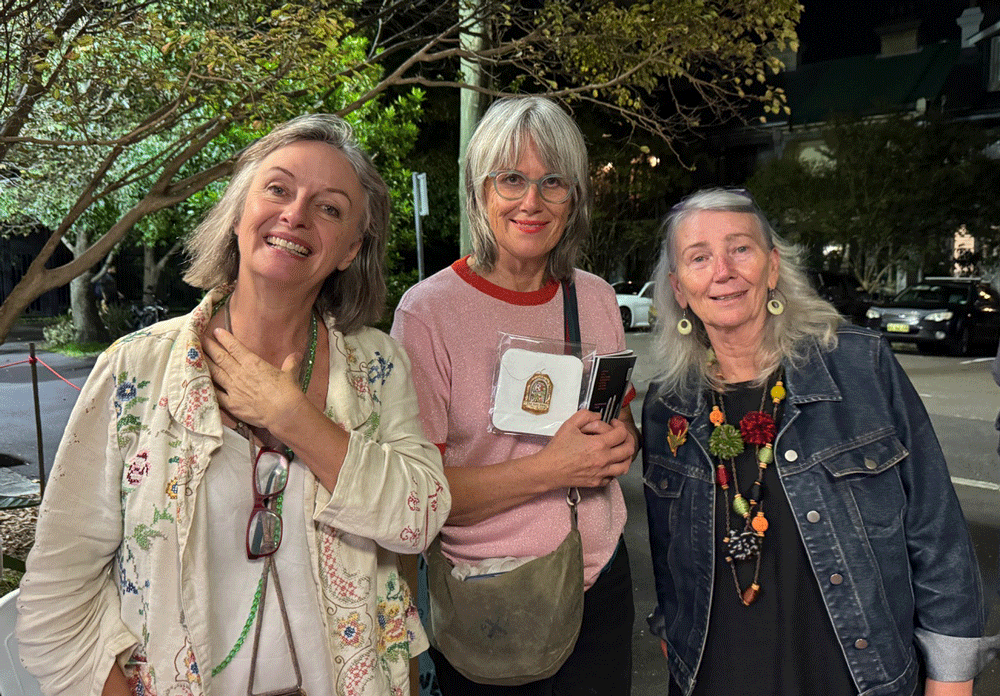Open Access
Published: July 2025
Licence: CC BY-NC-4.0
Issue: Vol.20, No.1
Word count: 2,653
About the author
Seasons of self: A timely reflection
Anita Lever
Abstract
This reflective paper explores the conceptual dialogues emerging from the exhibition On Ageing, curated by art therapist Skye Rogers at Chrissie Cotter Gallery in Camperdown, Sydney, in early 2025. Twenty-eight artists, including nine artist/art therapists, responded to themes of ageing through diverse creative contributions, exploring what it means to age, witness ageing in themselves and others, and consider growing older in the 21st century. Despite their varied approaches, the artworks created a cohesive response that examined contemporary ageing experiences through multiple mediums and perspectives. Accompanying workshops wove narrative connections between the pieces, creating safe spaces for visitors to witness, explore, and challenge social norms that limit our understanding of the scope and vitality of ageing. Together, the artworks and workshops offered fresh perspectives on the complexity and transformative potential of ageing. This project included the author’s own exploration through her painting in the exhibition and workshop facilitation, contributing to the broader contemporary dialogue about reimagining our relationship with the ageing process.
Keywords
Ageing, art exhibition, creative workshops, witnessing, transformation, community engagement
Cite this reflectionLever, A. (2025). Seasons of self: A timely reflection. JoCAT, 20(1). https://www.jocat-online.org/re-25-lever
In late 2024, artist and art therapist Skye Rogers, who lives and creates on the Wangal lands of the Eora Nation, developed a curatorial concept for an exhibition program titled On Ageing, a theme with the potential to challenge the negative cultural narratives on gendered ageism.
According to Westwood (2023), women face compounded discrimination as they age, experiencing both ageist and sexist attitudes simultaneously. In cultures that celebrate youth and sexualise younger women’s bodies, older women’s physical forms are often dismissed or undervalued. Women frequently struggle with a difficult choice: either trying to hide visible signs of their age, or embracing natural ageing while facing increased social stigma and discriminatory treatment. Chasin and Kramer (2022, as cited in Westwood, 2023) state that women often describe feeling invisible as part of their ageing experiences. Challenging patterns of erasure and invisibility, the On Ageing exhibition deliberately fostered space for alternative narratives to emerge, and for the images and creativity of older women to be seen.
Following a call-out, 28 artists including nine artist/art therapists responded to this complex and challenging theme through their own creative contributions. The artists took diverse artistic approaches that came together to communicate a united response. The exhibition and accompanying creative program were held at the Chrissie Cotter Gallery in Camperdown, Sydney, in April to May 2025.
Ageing is a vital area for exploration in Australian contemporary art that has resulted in limited research. In an arena often peppered with gendered ageism and invisibility, notable women artists such as Jenny Sages, Sue Ford, Christine Cornish, Pat Brassington and Kate Atkinson have delved into what, at times, can be a taboo topic. Winner of the People’s Choice Award in the 2019 National Photographic Portrait Prize, Atkinson claims her interest in exploring the varied perceptions of ageing and states, “In our society, as people get older, they may be treated differently or forgotten – the elderly may become seemingly invisible, but within these people are histories – exciting, incredible, rich lives… if only we take the time to ask” (National Portrait Gallery, 2019).
In her exhibition Paths to Portraiture (2010–11) at the National Portrait Gallery, Canberra, artist Jenny Sages celebrated four prominent elderly women who are distinguished within their own creative fields: painter Emily Kngwarreye, author Helen Garner, dancer Irina Baronova and Sages herself. Here we can see the artist moving into that space of the elderly, self-aware chronicler who recognises herself as part of this distinguished lineage, documenting her experience from the insider position of personal knowing.
Skye Rogers enthusiastically took up the baton and reignited that same spirit of enquiry by asking each participating artist in the On Ageing exhibition to pause and reflect for themselves, through their art process, on what it is to age, to witness ageing and to consider ageing, in the 21st century. Artists were invited to challenge the pervasive cultural subtext of images and messages that promote the desire and means to artificially slow down or stall the ageing process. These same promotions saturate our screens and tabloids daily, and ever-increasingly feed our internal critics. On Ageing countered these messages through a collective invitation to weave and reveal stories in a public space and expose the crevasses of time in all its magnificence – its weathering, its losses and gains, its presence as well as its absences.
The energy throughout the installation was palpable. As artworks were being dropped off, mini and cross-conversations among participating artists and the curatorial team sparked a stream of connectivity, reconnection and expectation of what was being realised. Trays of tea and cake were circulated as installers choreographed the spaces between the drop-offs. Conversations became heightened as the design and display of the show came to life. Blank walls became populated with an exploration of vigour and possibility.
With each artwork being installed, a collective visual conversation was being birthed across photography, painting, stitching, soft sculpture, drawing and mixed media. During the installation and while the exhibition was open to the public, I started to piece together the interconnectedness of the individual stories on identity, connection, loss and celebration. In considering what remains with me as I write this reflective piece, I now draw on the rich tapestry of materiality and approaches to ageing through art-making and writing, in ways that resonated across many conversations over the three weeks of the exhibition and workshop program.
The prospect of being asked to not only create an artwork and write an artist statement but also to facilitate a workshop at first seemed daunting; yet it was the touchstone that enabled me to immerse myself in a topic that had already been circulating in my mind and body for some time. This challenge proved motivation and spurred me on to find out for myself where I stand on the precipice of 65 years of age. What does that mean to me? How am I perceived by others and, more importantly, by myself?
Witnessing ageing can be heartbreaking. In early 2025, having had to make the difficult decision to euthanise my two ageing pets, Pushka and Bruno, I was profoundly immersed in and overcome by the difficult emotions of bidding a final farewell to precious family members a week apart from each other, both having shared my life over the last 17 years. Ageing, and ultimately death, is accelerated in the sentient creatures that fill our homes and hearts. It was during this fragile and creatively stagnant time that I was invited to participate in the On Ageing exhibition. A balm was gifted to me.
Sometimes paintings make themselves. Tidal Winds, which was painted over a ‘failed’ painting that I did some years previously, took a direction that ultimately moved the emotions that were flooding within me into the work itself. Saturated by these raw and recent losses, the painting opened a portal to reveal how nature holds us and our ancestors, and gives us language and expression far richer than our individual human thoughts and words can adequately articulate. Tidal Winds became a collaboration with water, with fire, with the wind. These agential forces of nature all offered metaphors for how we, as humans, can connect with non-human elements within a more profound subliminal context, giving expression to how we age, and to how we hold those beings whom we love so dearly through their own ageing process. As an ‘older’ woman purely by biological definition, my personal history shadows me. Over time, as water over rock, weathering and eroding, my decisions have etched into me deeper levels of understanding that are eventually replenished by an abundance of freshwater streams, inviting a new way to be, an acceptance to be still, quiet, restful, and at times unproductive.
Having completed the painting, I found the poem ‘Landscape’ (Quinn, 2015, pp.75–76) by the late Irish poet John O’Donohue, and immediately saw a connection that spoke directly to the painting in regard to respecting the non-human elements that surround us, that exist within us in our history, our emotional geography, and in how we are becoming.
Let us remember within us
The ancient clay,
Holding the memory of seasons,
The passion of the wind,
The fluency of water,
The warmth of fire,
The quiver-touch of the sun
And shadowed sureness of the moon
Like the poem, the painting felt solid, fluid, timeless and immersive.
Karen Barad’s concept of ‘intra-action’ (2012) reframes ageing through a new-materialist lens, not as an endpoint, but rather as an emergence through ongoing entanglements between bodies, environments and materials. This approach moves beyond viewing ageing as something that simply happens to passive subjects, instead understanding it as a dynamic evolving process shaped by material-discursive practices with pharmaceuticals, prosthetics, living spaces, and other non-human agents.
This theoretical lens helps me to view how this exhibition operated as more than a mere arrangement of artworks. It became an active assemblage where paint, canvases, wool, thread, as well as the gallery walls, the lighting and the ramp, actively participated in redefining the ageing narratives. The materiality of both the art and exhibition installation challenged ageist assumptions by revealing ageing as an ongoing, materially mediated process of transformation.
The artists/art therapists featured below responded to this provocation through their selected materials and forms. Their conceptual explorations are thoughtfully documented in artists’ statements throughout the beautifully designed 44-page exhibition catalogue.
Grafted to a large paper bag filled with torn brown papers, 60 dried tea bags – each dipped and infused with stories told around kitchen tables – become miniature canvases for Rogers’ mapping of her biological age in her artwork Proof of Life. She describes this work in her artist statement as an “old, crumpled, imperfect story” (2025, p.22). Each fragile piece serves as an historical witness to a year that cannot be chronicled by mere temporal markers. These delicate fragments imprint faces of loved ones, places called home, and silent moments of retreat and reflection. One tea bag image, year unknown, abstracts into a cluster of buttons; another captures a stained harbour view from a familiar home vantage point. Each tea bag acts as a tactile mnemonic that beckons the viewer to consider how much is revealed to the public eye and how much remains embedded like a private, embossed memory.
Photography serves as a profound medium for capturing and revealing time’s relentless passage, functioning simultaneously as witness, mirror and memento mori. In Jennifer Blau’s striking image Forget Me Not, the artist turns the self-gaze ever inward while time moves inexorably forward. The sitter holds a vintage mirror positioned between herself and the viewer, creating a deliberate obscuration of her face – a visual metaphor that speaks to the fragmented nature of changing identity.
The mirror becomes both revelation and concealment, reflecting moments when the sitter remains recognisable to herself, interspersed with instances where she becomes merely an actor in an ever-shifting performance. This theatrical metaphor gains poignancy as dementia claims its VIP seat, transforming the subject from protagonist to the observer of her own unfolding drama.
Wear and tear of the body and the mind is the piercing expression in Vicky Cutler Faire’s artwork Discarded (G)love. Faire reconsiders and repositions the overlooked and the discarded. Taking a ‘worn’ object that is no longer fit for purpose into a gallery space elevates its existence. With the care and patience of the artist’s hand, painstakingly embroidering into the fabric that once protected the gardener’s hands, Discarded (G)love now faces us, as we face it. We imagine, through adaptation, curiosity, and ultimately through care, a new purpose and life for the glove beyond what it once was. The arborist’s glove, once embroiled in soil and seasons, now bears witness to different kinds of cultivation and nurturing. Once abandoned, Discarded (G)love now exists as an object for contemplation, transformation, and renewed significance.
The exhibition was enriched by a purposefully designed workshop program featuring ten specially curated events that provided space for deeper and slower contemplation of ageing’s complex themes. These workshops, hosted by skilled creative facilitators, transformed the gallery into a dynamic environment where participants could deepen their engagement with the exhibition while exploring new materials, fostering meaningful conversations and developing creative skills. This integrated approach transformed the traditional gallery experience into something more immersive and participatory, where contemplation moved beyond observation to active creative engagement. Art therapist-led workshops included By the Book by Kerry Blake, Nature and Self by Jennifer Blau, Visible Mending by Vicki Cutler, Re-Writing the Script by Skye Rogers, and my own workshop titled Memory of Seasons.
Having signed up for the workshop Playing with Dolls/Meeting the Madwoman with Gill Brooks (a well-known Sydney-based felt artist), I was drawn to explore for myself what Brooks describes as “the Wise Woman as inspiration for a Memory Keeper Doll” (2025). This positive description of ageing as the memory keeper connected for me with contemporary author Sharon Blackie, as she does a deep dive into women and ageing through her many writings. This includes her concept ‘Hagitude’ (2022), which offers a radical reimagining of the second half of women’s lives through the lens of archetypal truth-telling figures extracted from European mythology and folklore.
Having been offered a wide choice of materials, including felt-making tools and wools, natural dyed silks and repurposed knitted garments, I embarked on the construction of my manifestation of my crone-self and honouring that description of older women. Choosing blue and brown fabrics and wools, my crone-self started to appear before me. The viewer could project their own face onto the felted featureless wool head. Her blue hair, a nod to her underwater self, was partly covered by the scarf and embroidery that recalled the ancestral time in the Slavic states where once she stood, farmed and danced.
One of the participants noted that she resembled the character Vasilisa from Vasilisa the Fair, a well-known Russian fairy tale that would have been familiar throughout the Slavic lands with which I am ancestrally connected. This unexpected recognition stirred something deep within me – a connection to the archetypal feminine wisdom that transcends generations. My memory keeper stood proud, her head tilted slightly toward the distance, holding her ground while holding space for non-linear time, embodying the timeless courage of Vasilisa, who navigated the liminal spaces between worlds.
The elements were active and alive on the night of my own workshop, Memory of Seasons. Rain flooded the gutters and soaked the pavements, and rivers of water cascaded down the outside glass walls, keeping some registered participants home and dry. Those that did attend were initially invited to engage in a body-scan meditation, followed by the opportunity to explore the theme of ageing through the invitation to contemplate nature, cycles and tides. Offering space for art-making and reflection creates a ‘time out of time’, in a place for creativity and connection to flourish. This session created a safe space that allowed personal themes and stories to arise and be shared and held by the group, following the quiet art-making time. One of the workshop participants agreed to share for this review how exploring the theme of ageing through her art-making has opened pathways to deeper personal work – specifically, by helping her begin the difficult process of saying goodbye to her father, whose health had begun deteriorating not long before the workshop.
The importance for women to have safe creative spaces and opportunities to play and connect to their own stories on ageing emerged as a strong recommendation, within the workshop and from the broader exhibition. Participants embraced the rare opportunity to play freely and reconnect with their own narratives around ageing.
On Ageing revealed the many seasons of self – each bringing its own wisdom, challenges and creative potential. Most significantly, there emerged a strong, shared recognition of the need to continue creating as an act of resistance – to stay ever visible in a world that too often renders ageing women invisible. Through art, story and community, the On Ageing exhibition created visibility, connection, and the radical act of remaining fully, vibrantly seen across all seasons of life.
In conclusion, I return to the title of my own painting, Tidal Winds, and how the metaphor of tides offers an alternative perspective on the ageing experience. Like the ocean’s rhythmic movements, ageing can be viewed as the natural tension between fullness and emptiness, advance and retreat. The tide of ageing gathers experiences and wisdom, then releases what no longer serves, all the while continuing to ebb and flow in patterns that reshape the seasons of self.
Like the wind that gradually carves away at our coastlines, we are reminded that change happens both suddenly and slowly through adaptation and resilience. As I move into my crone years, I find comfort in knowing that each low tide will be followed by the next cycle of fullness. The metaphor teaches us patience with the process and reverence for the natural rhythms that govern all life – reminding me that ageing, like the tides, is not necessarily decline but transformation.
The exhibition catalogue
Acknowledgements
The author acknowledges the traditional custodians of the Country on which the Chrissie Cotter gallery is located, the Gadigal of the Eora Nation, and recognise their continuing connection to land, waters and culture.
References
Barad, K. (2012). On touching – The inhuman that therefore I am. differences, 23(3), 206–223. https://doi.org/10.1215/10407391-1892943
Blackie, S. (2022). Hagitude: Reimagining the second half of life. September Publishing.
National Portrait Gallery. (2010). Jenny Sages: Paths to portraiture. https://www.portrait.gov.au/exhibitions/jenny-sages-2010
National Portrait Gallery. (2019, March 27). Textiles scientist voted the people’s favourite. [Press release]. https://www.portrait.gov.au/content/textiles-scientist-peoples-favourite
Quinn, J. (2015). Walking on the pastures of wonder: John O’Donohue in conversation with John Quinn. Veritas.
Rogers, S. (2025). On ageing [Exhibition catalogue]. Chrissie Cotter Gallery.
Westwood, S. (2023). “It’s the not being seen that is most tiresome”: Older women, invisibility and social (in)justice. Journal of Women & Ageing, 35(6), 557–572. https://doi.org/10.1080/08952841.2023.2197658
Author
Anita Lever
MAT, MArtAdmin, AThR
Anita Lever is an Australian art therapist who lives and works on Wangal Country, which is part of the Eora Nation. Her artistic journey commenced with a visual arts degree in the early 1980s, and evolved through a Master of Art Administration to her Master of Art Therapy. Her multidisciplinary practice spans two-dimensional media, performance and time-based installations. Currently, she is concentrating her focus on mapping interactions that span water-based experiences that transform sites into active spaces of enquiry. Recent Sydney exhibitions have showcased works connecting to these themes. Her research examines where art interfaces with therapy, environmental engagement and embodied learning. By refusing fixed modes of viewing, Lever creates conditions for emergent understanding, demonstrating how creative enquiry bridges personal growth, community engagement and ecological awareness.


